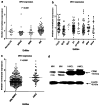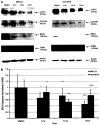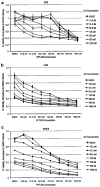Genome-wide studies in multiple myeloma identify XPO1/CRM1 as a critical target validated using the selective nuclear export inhibitor KPT-276
- PMID: 23752175
- PMCID: PMC3922416
- DOI: 10.1038/leu.2013.172
Genome-wide studies in multiple myeloma identify XPO1/CRM1 as a critical target validated using the selective nuclear export inhibitor KPT-276
Abstract
RNA interference screening identified XPO1 (exportin 1) among the 55 most vulnerable targets in multiple myeloma (MM). XPO1 encodes CRM1, a nuclear export protein. XPO1 expression increases with MM disease progression. Patients with MM have a higher expression of XPO1 compared with normal plasma cells (P<0.04) and to patients with monoclonal gammopathy of undetermined significance/smoldering MM (P<0.0001). The highest XPO1 level was found in human MM cell lines (HMCLs). A selective inhibitor of nuclear export compound KPT-276 specifically and irreversibly inhibits the nuclear export function of XPO1. The viability of 12 HMCLs treated with KTP-276 was significantly reduced. KPT-276 also actively induced apoptosis in primary MM patient samples. In gene expression analyses, two genes of probable relevance were dysregulated by KPT-276: cell division cycle 25 homolog A (CDC25A) and bromodomain-containing protein 4 (BRD4), both of which are associated with c-MYC pathway. Western blotting and reverse transcription-PCR confirm that c-MYC, CDC25A and BRD4 are all downregulated after treatment with KPT-276. KPT-276 reduced monoclonal spikes in the Vk*MYC transgenic MM mouse model, and inhibited tumor growth in a xenograft MM mouse model. A phase I clinical trial of an analog of KPT-276 is ongoing in hematological malignancies including MM.
Trial registration: ClinicalTrials.gov NCT01607892.
Conflict of interest statement
AKS provides consulting services for Millennium and Celgene. MK and SS are founders of and hold equity in Karyopharm. DM is employed by Karyopharm. PLB provides consulting services for Onyx. The remaining authors declare no conflict of interest.
Figures






References
-
- Brenner H, Gondos A, Pulte D. Recent major improvement in long-term survival of younger patients with multiple myeloma. Blood. 2008;111:2521–2526. - PubMed
Publication types
MeSH terms
Substances
Associated data
Grants and funding
LinkOut - more resources
Full Text Sources
Other Literature Sources
Medical
Molecular Biology Databases

